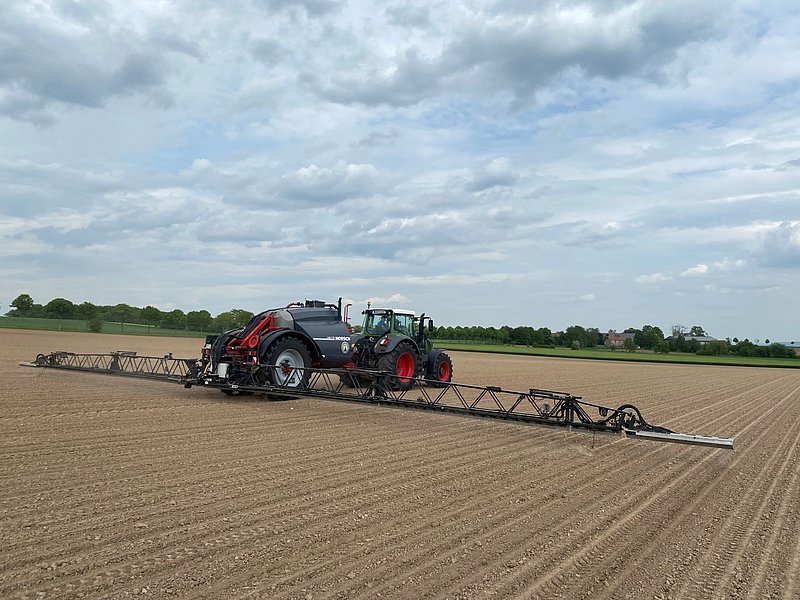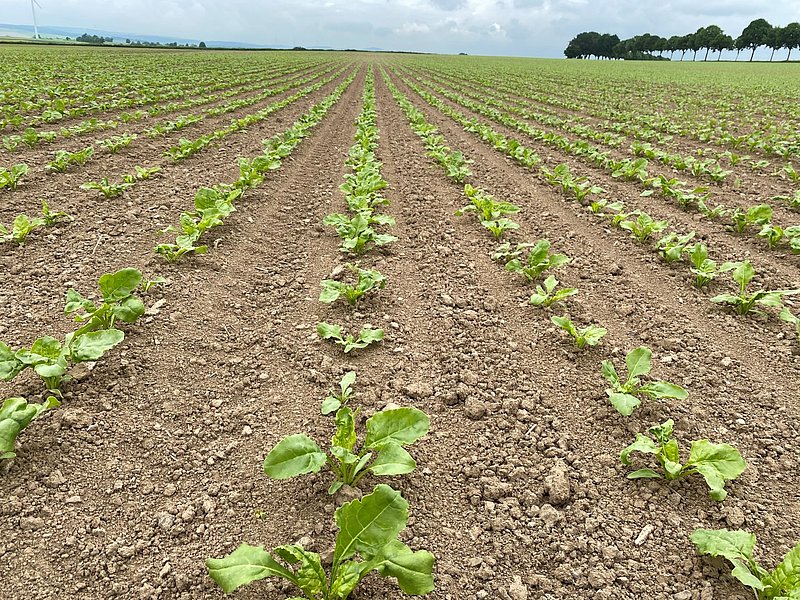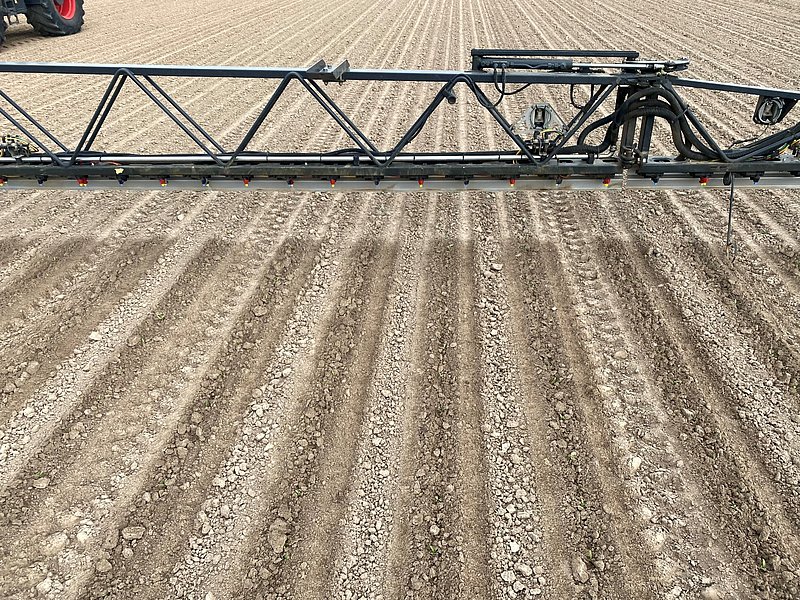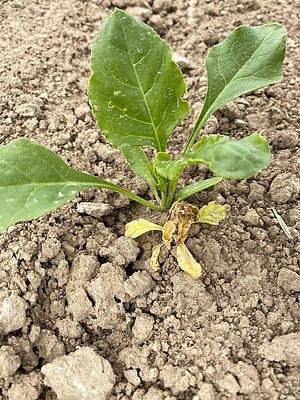Band spraying – convincingly efficient
Volker Gröblinghoff is a graduate farmer. After this master studies which he passed in Göttingen and Bonn he started to work for the Freiherr von Weichs KG, an arable farm in East Westphalia. He currently is the assistant of the management and is responsible for the outdoor operations of the arable farm.
terraHORSCH: Mr Gröblinghoff, what are the most important crops on your farm?
Volker Gröblinghoff: Our cultivated land amounts to approx. 1,000 hectares. We grow typical cash crops like rape, wheat and spelt but sugar beet and potatoes also are important crops as well as silage maize and field beans. The beets still have a rather high share in the rotation of the farm and their yield definitely plays a role for the farm profit. For ecological and economic reasons, we use the band spraying method for sugar beet.

terraHORSCH: What is the position of sugar beet in your rotation?
Volker Gröblinghoff: In our rotation sugar beet comes after cereals, normally after barley, wheat or spelt. After the beet, we grow wheat as well as spelt. The ratio of the cultivated land of spelt and wheat varies depending on the market situation. Maize usually is not part of our intensive sugar beet rotation. The geographic as well as the climatic conditions are not optimum for the cultivation of maize and the demand for silage resp. biogas maize is not very high.

terraHORSCH: The fields of the farm are located at different altitudes. What are the special challenges?
Volker Gröblinghoff: Yes, our soils are very heterogeneous. There partly are very heavy clayey soils that have to be treated very carefully with regard to the cultivation in spring. They often are really challenging especially when sowing beet. To achieve a good sugar beet seed bed, tillage is partly carried out before the winter. For several years, the winter furrow has been proving its worth on the fields with a high share of clay. In fields where because of the soil quality we cannot grow sugar beet, we have included rape into the rotation instead of the beet. Our less hilly fields towards the Warburger Börde are significantly siltier. It is easier to grow beet and potatoes in these soils.
In total, our site is relatively wet even if it seems to be different because of the dry periods during the past years. But in principle arable farming at the Borlinghausen site is very much marked by rain. And these conditions are very challenging.
terraHORSCH: What was the average rainfall in the past years?
Volker Gröblinghoff: I would say: between 800-900 mm/m² on average, last year we had just under 700 mm. Thus approx. 200 mm less. This year, we already had about 500 mm/m² until October. In a way, the unusually dry conditions facilitate the cultivation of our soils, even if the extreme drought in spring resulted in yield deficits especially for sugar beet.

terraHORSCH: How did you come to deal with band spraying and why did you finally decide to use this method on your farm?
Volker Gröblinghoff: On some of our beet sites we have enormous problems with weed beet. This is why we wondered how we could cope with this more easily so that we could avoid the laborious manual work of removing the weed beet. There is a new system by KWS and Bayer: the Conviso cultivation system consisting of seed and herbicide. In our region, this year the systemic herbicide was only allowed for max. 45 % of the fields as a band application. For this cultivation year we were able to purchase seed and the corresponding herbicide which also safely removes weed beets that are not tolerant against this agent. Thus, due to the approval of this herbicide we were directly faced with band spraying and the topic was considerably more present on our farm than before. To get our fields clean, we use the sprayer as a band sprayer in combination with a hoe.
terraHORSCH: Which row widths are you working with?
Volker Gröblinghoff: For sugar beet we are working with a row spacing of 45 cm. The sprayer, a HORSCH Leeb 7 GS, has a working width of 27 m with a 25 cm nozzle layout.
terraHORSCH: How did you retrofit the machines?
Volker Gröblinghoff: We installed the angled HORSCH nozzle caps. There are two different angled caps: a grey one and a red one. With the angled caps, the straight nozzle caps and blind caps we were able to realise band spraying for beet with a row width of 45 cm and a nozzle spacing of 25 cm.
To test the whole system without using a herbicide straight away, we used water to test the application and the adjustments in the field. With the RowFan nozzles 40 02, the water quantity amounted to 300 l/ha. We, thus, were able to test a lot of things, adjust the boom to the optimum height and to determine the width of the band that is appropriate for us. To achieve a 20 cm band, we had to turn the nozzles to an offset position of 45° in the nozzle holder. Due to the exact height control of the boom with BoomControl the width of the application band was safely kept up and thus, the correct agent concentration could be spread on the defined area. As soon as we were convinced that it worked, we used the herbicide. At first, we constantly checked the system by permanently watching the impact of the spraying film. Thus, we could be sure that it worked reliably, and that the herbicide was applied in the area which is not kept clean mechanically by the hoe.

terraHORSCH: What was the biggest challenge with regard to the adjustment?
Volker Gröblinghoff: The biggest challenge for us was driving the track control at the tractor in such a way that the band was right in the middle above the beet row. There is a certain play in the longitudinal axle of the sprayer. We drove with a blocked steering axle and used the RTK steering system of the tractor for possible corrections to move the machine one centimeter to the left or to the right to avoid drifting off and to always apply the band centrically above the row.

terraHORSCH: What is your conclusion?
Volker Gröblinghoff: This year, we carried out only one application as after the drought no further weeds emerged. The field is completely clean and does not look any different compared to the beet field over the road where we used our traditional herbicide method all over the field.
As a hoeing machine we used a Farmdroid robot in this field which within the row can hoe near the beet plant with RTK accuracy. However, weeds that grow directly at the beet plant is not seized so that a merely mechanical weed management did not achieve the desired result of a weed-free beet field. But with the sprayer we succeeded really well. In total, band spraying in combination with the hoeing machine completely convinced us and generated a clean beet field. The boom was reliably kept at the low application height of approx.28 cm with an appropriate operational speed so that wetting was optimum.